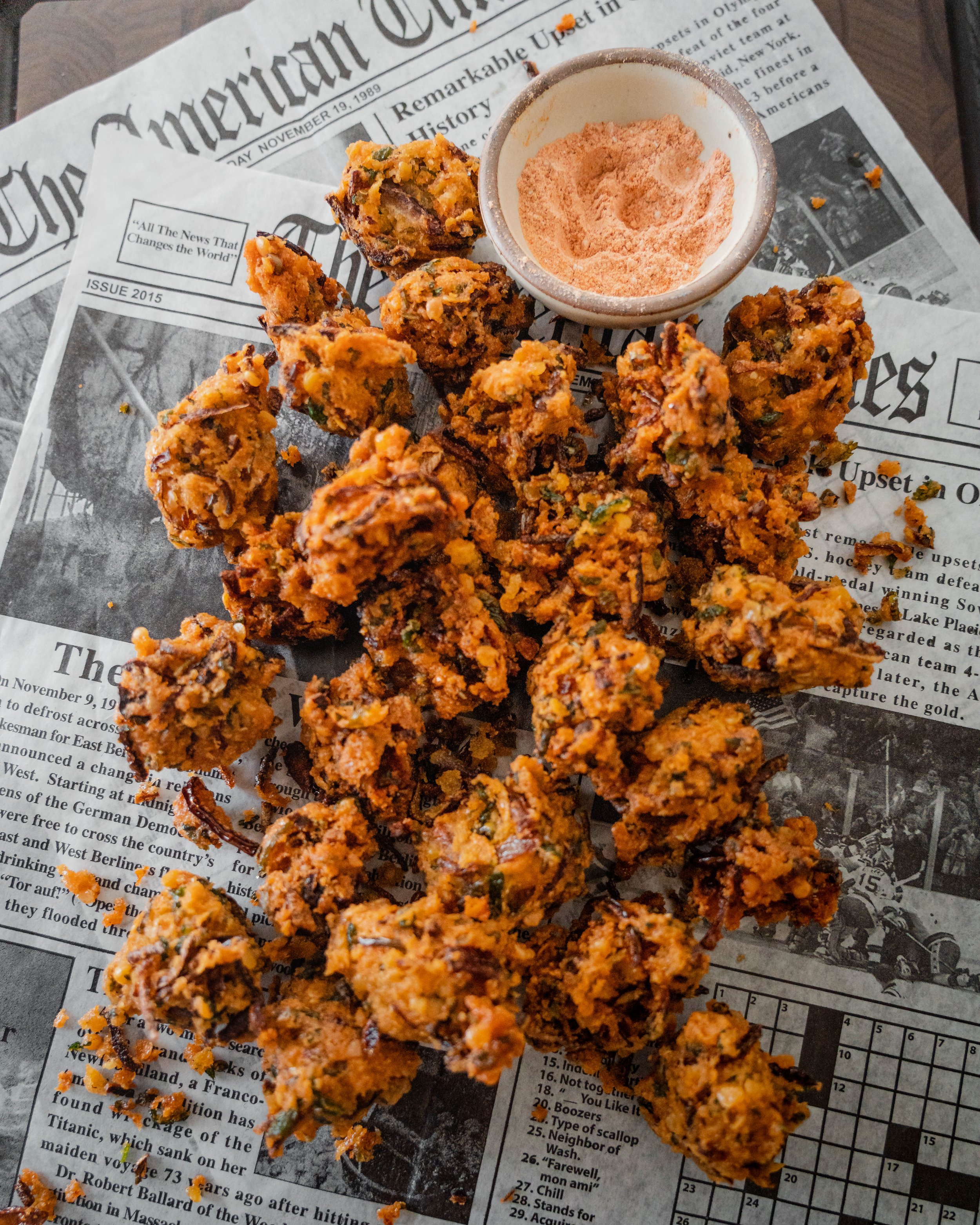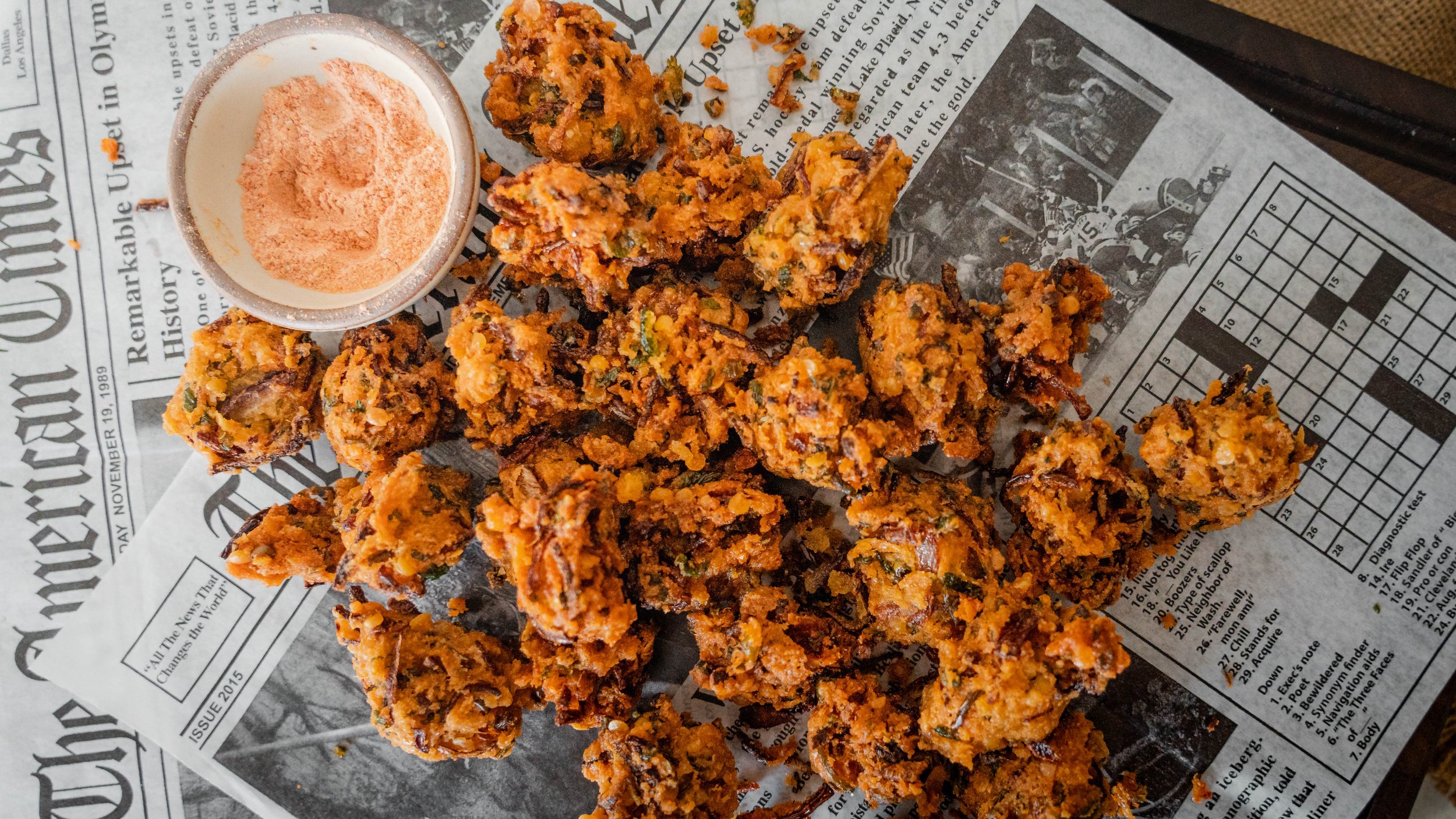Piyaju

If it’s deep fried, it is Bengali! Piyaju, loosely translated to spicy onion fritters. This is a crispy bite sized snack and is loved by the whole nation, a special treat popular during the month of Ramadan.
Video Tutorial
Pakora and onion bhajis from the Indian subcontinent and falafel from the Middle East are probably the distant cousins of the Bengali Piyaju. But if you’ve had it before, you know it’s a very unique snack and no amount of pakora, falafel or onion bhajis will satiate your cravings for piyaju.
Although nowadays people describe it as red lentil fritters, "Piyaju" comes from the Bengali word “piyaj” which means onion. I once read somewhere that it originated as a snack entirely made of sliced onions with a little bit of lentil paste to act as the binding agent. Overtime as prices of onions increased, to offset the cost people started using equal portion of lentils and onions in the batter. Fun fact — red lentil fritter is “daaler bora” whereas onion fritter is “piyaju”. Moving forward, I am going to be the #ladywithsign holding a cardboard saying “Piyaju is NOT red lentil fritters!”.
Typically Piyaju is served with a side of spicy ketchup or a black salt (beet lobon) and red chili powder mix (as pictured here). Although it is considered a specialty during Iftar in Ramadan, it is also every Bengali households go to afternoon snack with a side of doodh cha. There is just a je-ne-sais-quoi about eating a piping hot and intensely spicy piyaju with a cup of sweetened milky chai!
In fact, we love piyaju so much that not only do we eat it as snacks on their own but we even crumble them up and add them to jhal muri, and sometimes eat them as side dishes with rice and dal. Lol I joke around and call it the lentil-ception because dal is lentil soup while piyaju is fried lentils. But in all honestly, piyaju with dal is actually really delicious! It’s just how we do, and the versatile piyaju is one of the best things about being Bengali (ethnicity) and Bangladeshi (nationality).
Recipe — Piyaju
Bangladeshi Onion Fritters
Serving Size: 6
Ingredients
Red lentils - 2 cups, soaked 4 hours at least, best if soaked overnight
Red Onions - 1 large or 2 med, sliced thin
Ginger - 2 tbsp, diced
Bird's eye chili - 5-6, thinly diced
Salt - 1½ Tsp
Cilantro - ¼ cup chopped
Oil - enough to deep fry, make sure it's neutral oil (peanut/ canola/vegetable)
Making the batter
Strain the lentils from the soaking water, about half an hour before making the batter — this helps getting rid of the excess moisture. Remember wet batter = soggy fritters + hot oil explosion.
Set aside about 1/8 cup lentils and coarse-grind the rest with the ginger.
Note: the water stuck to the lentils should be enough but if it's too dry in the blender, you can add 1 tbsp water at a time. Try not to make it a wet batter, It should be a dry dough like consistency.
In a large bowl, separate the sliced onions and combine it with the diced chilis, cilantro and salt.
Add the red lentil paste and the whole lentils that was set aside earlier. Combine the lentil mix really well with the onion and herbs mix.
Note: do not make the batter ahead of time and do not let the batter sit around. You must start frying immediately after you make the batter.
In a wide Dutch oven over medium heat, add enough oil to submerge and deep fry the fritters.
Note: patience is key if you want the perfect crumbly and crispy piyaju, and in general when you are deep frying anything.
Wait until the oil is hot to add the fritters. How to tell if the oil is ready — when you stick a chopstick or wooden skewer, if the oil starts to form bubbles around it, then it's ready.
Frying the Piyaju
I have a bone to pick with people who turn piyaju into perfect little balls or round and flat shami kabab shape. That is not how piyaju should be! Piyaju is meant to be a formless fritter with slivers of onions sticking out. If you don’t believe me, check out these videos of how street vendors make Piyaju back in Bangladesh here and here. It is one of the most popular street food back home and those vendors know what they are doing!
Then there is also the cooking science — when it’s free form and shapeless, it also has plenty of nooks and crannies where the oil will seep in while frying, resulting in an incredibly crispy texture both inside and outside. My trick to getting the perfect bite size piyaju is how you (not) shape the fritters and implementing the double fry method!
First Fry
With all 5 fingers pick up the batter. The idea is to only pick up as much onion and lentil mix as your five fingers allow. Gently let go and drop what you are holding in the hot oil right away. Do not try to flatten or shape what you pick up. Also try not to overcrowd the Dutch oven, its best to fry them in batches of 10-12 (depending on how wide or compact your frying pan is).
The piyaju will sink to the bottom and may even stick to the bottom when you first drop them in the hot oil. Do not fret and do not touch it. Once the oil starts to seep in, they will unstick from the bottom on their own and start floating to the top.
Once the piyajus are floating and the bottom has changed to a light yellow color, flip it on the other side. Continue flipping every now and then until they have formed a pale yellow-orange color.
Remove them from the hot oil and allow them to cool down in a tray lined with paper towel. Repeat step 1 to 4 for the rest of the batter.
Once you have fried all the piyajus into a somewhat pale yellow-orange color, set them aside in the tray and allow them to cool down for 30 minutes to an hour, if you have the time. If you do not have the time, then it’s okay but try to space them apart as you set them aside while frying. Piling them will not allow the excess moisture to evaporate and we don’t want a soggy piyaju.
Second Fry
After letting the piyaju rest for an hour, in the same Dutch oven with the frying oil, turn up the heat all the way up to high. The second fry is meant to quickly shock the piyaju in intense heat so the exterior forms an extremely crispy outer layer.
This time you are allowed to overcrowd the pan while frying. Add back as many piyajus as it can fit and allow them to fry for another 1-2 minutes. Nudge and flip them along as they are frying.
They will start to darken their color right away but be careful not to burn them. As soon as the orange color starts to turn into a medium brown, remove the piyaju and place them back in the sheet pan lined with paper towel. Repeat the step for the rest of the piyaju.
Let the paper towel soak up the excess oil then transfer them over to a serving platter. I like to serve them with either spicy ketchup or a mixture of black salt and red chili powder (as seen in the video) — which is also the most iconic way and how they are traditionally served as street food in Bangladesh.
Why did you not add any ground spices?
The beauty of a piyaju is that it relies solely on fresh ingredients — lots of onions obviously, but also green chilies, ginger and fresh herbs like cilantro. In it’s entirety and literal translation it is an onion fritter. You are to let the sweet and pungent flavors of the onion shine here, which can be taken away and masked when we use ground spices. You may add a pinch of turmeric for color, but when you double fry the way I recommend it, there is really no need. With the intense heat from frying them twice, it will develop it’s own beautiful dark orange hue.
Why Double Fry?
Frying is first and foremost a dehydration process. This means that the drier your food is when you start frying, the better your crust will be. After the first fry, moisture in the center of the food migrates to the surface once it cools and the surface gets soggy again. Then you boil off that moisture again on the second fry with a more intense heat.
The first fry also changes the microscopic architecture of the food. The oil pushes into the food through air pockets that are, in the beginning, warped and twisted channels, making those pathways simpler and merging with each other as it fries. On that second fry, these straightened, simple pathways make it easier for water to escape, giving you a drier, crisper fritter.
In the direction above, I mention letting the piyaju rest for at least 30 minutes to 1 hour after the first fry. By letting the fritter rest and cool between the dips in the oil, additional water evaporates from the skin. This is also why I recommend spacing them apart (if you don’t have the time) while resting so moisture doesn’t develop and instead they evaporate quicker.
I have also noticed when you fry piyaju once, the inside still has a soggy and dough like texture. But when I double fry them by putting them back in piping hot oil, the inside fried as well giving it a hollow and crunchy interior, while the exterior turned brown and crispy. If you are a regular on the blog or on our Instagram, you already know how much I love to talk about double frying. If I am deep frying something, I will pretty much always implement the double fry techniques. Here are more of my recipes that used this frying method — Korean Fried Chicken, Vietnamese Fried Spring Rolls, Canadian Poutine, and British Fish & Chips.
So there you have it! This is my way of taking an already amazing traditional Bengali dish and enhancing it with the knowledge of science. I hope you like this piyaju as much as we do and if you have any questions or concerns, be sure to leave a comment below. Cheers!
If you do recreate our recipes, be sure to
TAG & FOLLOW @TheSpiceOdyssey
Stay up to date with us on Instagram, Pinterest, Youtube and Facebook.

